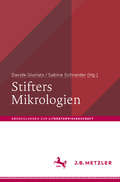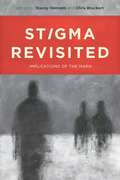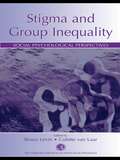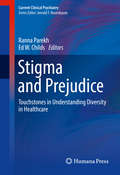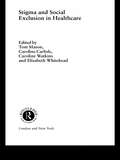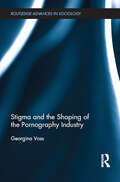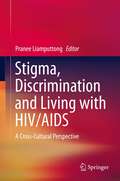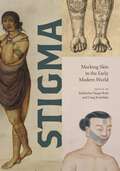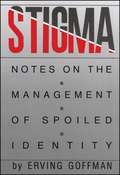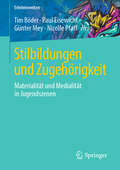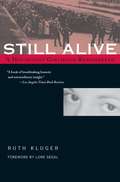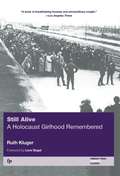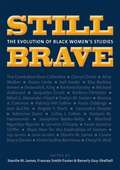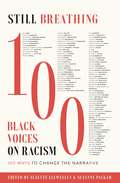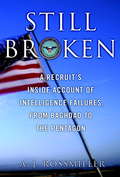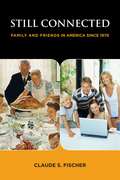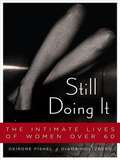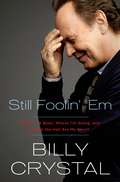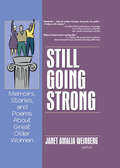- Table View
- List View
Stiffed: The Betrayal of the American Man
by Susan FaludiOne of the most talked-about books of last year, the Pulitzer Prize-winning author of Backlash now explores the collapse of traditional masculinity that has left men feeling betrayed. With Backlash in 1991, Susan Faludi broke new ground when she put her finger directly on the problem bedeviling women, and the light of recognition dawned on millions of her readers: what's making women miserable isn't something they're doing to themselves in the name of independence. It's something our society is doing to women. The book was nothing less than a landmark. Now in Stiffed, the author turns her attention to the masculinity crisis plaguing our culture at the end of the '90s, an era of massive layoffs, "Angry White Male" politics, and Million Man marches. As much as the culture wants to proclaim that men are made miserable--or brutal or violent or irresponsible--by their inner nature and their hormones, Faludi finds that even in the world they supposedly own and run, men are at the mercy of cultural forces that disfigure their lives and destroy their chance at happiness. As traditional masculinity continues to collapse, the once-valued male attributes of craft, loyalty, and social utility are no longer honored, much less rewarded. Faludi's journey through the modern masculine landscape takes her into the lives of individual men whose accounts reveal the heart of the male dilemma. Stiffed brings us into the world of industrial workers, sports fans, combat veterans, evangelical husbands, militiamen, astronauts, and troubled "bad" boys--whose sense that they've lost their skills, jobs, civic roles, wives, teams, and a secure future is only one symptom of a larger and historic betrayal.
Stiffed: The Roots Of Modern Male Rage
by Susan Faludi“A groundbreaking, 600 page treatise that shines feminism’s insights into various corners of masculinity in a way that hasn’t been done before . . . Stiffed is eye-opening enough to change the way we understand each day’s news.” — Boston Sunday Globe“Faludi masterfully weaves larger essays with case histories and personality profiles. She connects the general to the specific and enlivens her argument with a host of haunted voices.” — Washington Post Book World“Susan Faludi’s Backlash . . .[is] the most important book on women in recent decades . . . Stiffed is even better than Backlash. It is a significant and serious work.” — New York Review of Books“The worst thing about Stiffed: The Betrayal of the American Man is that you immediately want to run around grabbing people by the lapels and beseeching them, “Read this book! Now! I’ve got to talk about it . . . ” — San Diego Union Tribune“[Susan Faludi’s] ear knows how to listen; her heart is made of sympathy; her mind is always changing... Brilliant book. ” — John Leonard, New York Newsday“In this monumental and surprising book, sure to make a tremendous impact on thoughtful people, [Faludi] overlooks no part of the national landscape . . . As in her Pulitzer-Prize-winning Backlash, Faludi accuses society, and documents her claims. Read Stiffed. You’ll never forget it.” — Harriete Behringer“[Stiffed] is the product of six years of aggressive reporting and an admirable knack for bringing the results to life. No one will ever put this book down for lack of vivid scene setting or compassionate observation.” — The New York Times Book Review“[Stiffed is] a work of astonishing compassion . . . It issues a dare for both men and women who’ve long been dunned into passivity to do something significant to change their lives, to reject the values of a society that would prefer for them to seek easy answers.” — Seattle Weekly
Stifters Mikrologien (Abhandlungen zur Literaturwissenschaft)
by Sabine Schneider Davide GiuriatoDas Werk Adalbert Stifters zeichnet sich durch eine markante Aufmerksamkeit für das Kleine und vermeintlich Geringfügige aus, er gilt als Dichter des Details. Bereits die zeitgenössische Kritik hat sein „Diminutivtalent“ und Interesse für das „Kleinleben der Natur“ ins Visier genommen. So wie sich die Humanwissenschaften methodologisch auf die unwichtigen Nebensächlichkeiten, auf das Netz von geringfügigen Indizien und Symptomen zu stützen beginnen, so entdeckt dieser Sammelband Stifters Mikrologie als eine „unsichere Wissenschaft“, die sich gerade über unmerkliche Wahrnehmungen Aufschluss über größere Zusammenhänge erhofft. Der Zusammenhang von Literatur und Wissen, der hier aufgedeckt wird, bezieht sich auf Natur ebenso wie auf soziale Phänomene und beschreibt einen wesentlichen Aspekt der Poetologie Stifters.
Stigma Revisited: Implications of the Mark (Alternative Perspectives in Criminology)
by Stacey Hannem & Chris BruckertStigma Revisited: Implications of the Mark is a collection of qualitative, empirical studies of populations who experience stigma. Discrimination, marginality and social injustice are recognized as indelibly tied to the phenomena of stigma. This volume builds on the work of Erving Goffman and integrates a larger, structural understanding of stigma based in Michel Foucault’s governmentality writings. Contemporary notions of risk, riskiness and danger are linked to the labelling of “deviant” populations in the name of social control and risk management; these labels result in the institutional and systemic perpetuation of stereotypes and stigmatic attitudes. The research presented in this book addresses the individual experience of symbolic stigma as well as the collective impact of structural stigma. With unique, personal vignettes that position each of the academic contributors in relation to their subjects, this collection of essays challenges social science researchers to understand their own role in reproducing and contesting hegemonic discourses that stigmatize and marginalize.
Stigma and Culture: Last-Place Anxiety in Black America (Lewis Henry Morgan Lecture Ser.)
by J. Lorand MatoryIn Stigma and Culture, J. Lorand Matory provocatively shows how ethnic identification in the United States—and around the globe—is a competitive and hierarchical process in which populations, especially of historically stigmatized races, seek status and income by dishonoring other stigmatized populations. And there is no better place to see this than among the African American elite in academia, where he explores the emergent ethnic identities of African and Caribbean immigrants and transmigrants, Gullah/Geechees, Louisiana Creoles, and even Native Americans of partly African ancestry. Matory describes the competitive process that hierarchically structures their self-definition as ethnic groups and the similar process by which middle-class African Americans seek distinction from their impoverished compatriots. Drawing on research at universities such as Howard, Harvard, and Duke and among their alumni networks, he details how university life—while facilitating individual upward mobility, touting human equality, and regaling cultural diversity—also perpetuates the cultural standards that historically justified the dominance of some groups over others. Combining his ethnographic findings with classic theoretical insights from Frantz Fanon, Fredrik Barth, Erving Goffman, Pierre Bourdieu and others—alongside stories from his own life in academia—Matory sketches the university as an institution that, particularly through the anthropological vocabulary of culture, encourages the stigmatized to stratify their own.
Stigma and Group Inequality: Social Psychological Perspectives (Claremont Symposium on Applied Social Psychology Series)
by Shana Levin Colette Van LaarThis book provides a snapshot of the latest theoretical and empirical work on social psychological approaches to stigma and group inequality. It focuses on the perspective of the stigmatized groups and discusses the effects of the stigma on the individual, the interacting partners, the groups to which they belong, and the relations between the groups.Broken into three major sections, Stigma and Group Inequality:*discusses the tradeoffs that stigmatized individuals must contend with as they weigh the benefits derived from a particular response to stigma against the costs associated with it;*explores the ways in which environments can threaten one's intellectual performance, sense of belonging, and self concept; and*argues that the experience of possessing a stigmatized identity is shaped by social interactions with others in the stigmatized group as well as members of other groups.Stigma and Group Inequality is a valuable resource for students and scholars in the fields of psychology, sociology, social work, anthropology, communication, public policy, and political science, particularly for courses on stigma, prejudice, and intergroup relations. The book is also accessible to teachers, administrators, community leaders, and concerned citizens who are trying to understand and improve the plight of stigmatized individuals in school, at work, at home, in the community, and in society at large.
Stigma and Prejudice
by Ranna Parekh Ed W. ChildsIn this innovative title, the authors describe unique patient populations affected by stigma and prejudice and the prevalence of these issues to all healthcare providers. Each chapter covers the forms of prejudice and stigma associated with minority statuses, including religious minorities, the homeless, as well as those stigmatized by medical serious medical conditions, such HIV/AIDS, obesity, and substance misuse disorders. The chapters focus on the importance of recognizing biological differences and similarities within such groups and describes the challenges and best practices for optimum healthcare outcomes. The text describes innovative ways to connect in a clinical setting with people of diverse backgrounds. The text also covers future directions and areas of research and innovative clinical work being done. Written by experts in the field, Stigma and Prejudice is an excellent resource for psychiatrist, psychologists, general physicians, social workers, and all other medical professionals working with stigmatized populations.
Stigma and Social Exclusion in Healthcare
by Tom Mason Caroline Watkins Caroline Carlisle Elizabeth WhiteheadWhilst those in healthcare might like to think that they work to reduce stigma and social exclusion of others, this book reveals many strategies by which healthcare professionals contribute to increasing these conditions. Written by practitioners, some of whom have themselves been stigmatised, the book exposes the hidden processes of prejudice and the dogma of ideology that permeate contemporary healthcare. Engaging with the realities of stigma through a grassroots approach, topics covered include:* hearing* sight* sexuality* HIV and AIDS* drug use* teenage pregnancy* breastfeeding* old age.Stigma and Social Exclusion in Healthcare provides practical solutions to problems, recommendations for training and a blueprint for the future. It will prove a valuable reference for all those wanting to deal with the issues of stigmatisation.
Stigma and the Shaping of the Pornography Industry (Routledge Advances in Sociology)
by Georgina VossThe idea of ‘pornography’ is often employed to invoke titillation, anger, and disgust. Stigma and the Shaping of the Pornography Industry explores the effects that this stigmatized identity has on the pornography industry itself. From the video era to the emergence of the internet, to trade shows, white-collar workers, technological innovation, and industry-wide characteristics, this book looks beyond content production to explore how stigma has shaped the structures, practices, norms, and boundaries of the wider sector. By drawing on concepts such as dirty work, core-stigmatized industries, and outlaw innovation, this book offers rich insights into the ways in which stigma is socially constructed and managed, and the deep structural effects that it has on the industry.
Stigma, Discrimination and Living with HIV/AIDS
by Pranee LiamputtongUp until now, many articles have been written to portray stigma and discrimination which occur with people living with HIV/AIDS (PLWHA) in many parts of the world. But this is the first book which attempts to put together results from empirical research relating to stigma, discrimination and living with HIV/AIDS. The focus of this book is on issues relevant to stigma and discrimination which have occurred to individuals and groups in different parts of the globe, as well as how these individuals and groups attempt to deal with HIV/AIDS. The book comprises chapters written by researchers who carry out their projects in different parts of the world and each chapter contains empirical information based on real life situations. This can be used as an evidence for health care providers to implement socially and culturally appropriate services to assist individuals and groups who are living with HIV/AIDS in many societies. The book is of interest to health care providers who have their interests in working with individuals and groups who are living with HIV/AIDS from a cross-cultural perspective. It will be useful for students and lecturers in courses such as anthropology, sociology, social work, nursing, public health and medicine. In particular, it will assist health workers in community health centres and hospitals in understanding issues related to HIV/AIDS and hence provide culturally sensitive health care to people living with HIV/AIDS from different social and cultural backgrounds. The book is useful for anyone who is interested in HIV/AIDS-related stigma and discrimination in diverse social and cultural settings.
Stigma: Marking Skin in the Early Modern World (Perspectives on Sensory History)
by Katherine Dauge-Roth and Craig KoslofskyThe early modern period opened a new era in the history of dermal marking. Intensifying global travel and trade, especially the slave trade, bought diverse skin-marking practices into contact as never before. Stigma examines the distinctive skin cultures and marking methods of Asia, Europe, Africa, and the Americas as they began to circulate and reshape one another in the early modern world. By highlighting the interwoven histories of tattooing, branding, stigmata, baptismal and beauty marks, wounds and scars, this volume shows that early modern markers of skin and readers of marked skin did not think about different kinds of cutaneous signs as separate from each other. On the contrary, Europeans described Indigenous tattooing in North America, Thailand, and the Philippines by referring their readers to the tattoos Christian pilgrims received in Jerusalem or Bethlehem. When explaining the devil’s mark on witches, theologians claimed it was an inversion of holy marks such as those of baptism or divine stigmata. Stigma investigates how early modern people used permanent marks on skin to affirm traditional roles and beliefs, and how they hybridized and transformed skin marking to meet new economic and political demands.In addition to the editors, the contributors to this volume are Xiao Chen, Ana Fonseca Conboy, Peter Erickson, Claire Goldstein, Matthew S. Hopper, Katrina H. B. Keefer, Mordechay Lewy, Nicole Nyffenegger, Mairin Odle, and Allison Stedman.
Stigma: Notes on the Management of Spoiled Identity
by Erving GoffmanFrom the author of The Presentation of Self in Everyday Life, Stigma is analyzes a person’s feelings about himself and his relationship to people whom society calls “normal.”Stigma is an illuminating excursion into the situation of persons who are unable to conform to standards that society calls normal. Disqualified from full social acceptance, they are stigmatized individuals. Physically deformed people, ex-mental patients, drug addicts, prostitutes, or those ostracized for other reasons must constantly strive to adjust to their precarious social identities. Their image of themselves must daily confront and be affronted by the image which others reflect back to them.Drawing extensively on autobiographies and case studies, sociologist Erving Goffman analyzes the stigmatized person’s feelings about himself and his relationship to “normals” He explores the variety of strategies stigmatized individuals employ to deal with the rejection of others, and the complex sorts of information about themselves they project. In Stigma the interplay of alternatives the stigmatized individual must face every day is brilliantly examined by one of America’s leading social analysts.
Stigmatisierende Kommunikation: Eine theoretische Konzeptualisierung gruppenbezogener abwertender Kommunikation
by Anna FreytagDie Arbeit von Anna Freytag setzt sich theoretisch mit dem Phänomen der gruppenbezogenen abwertenden Kommunikation auseinander. Die Kommunikationswissenschaft und andere Disziplinen haben sich in der Vergangenheit unter einer Vielzahl von Begriffen und aus unterschiedlichen theoretischen Perspektiven mit gruppenbezogener abwertender Kommunikation auseinandergesetzt. Die etablierten Begriffe bergen jedoch Herausforderungen und vernachlässigen zum Teil soziologische und sozialpsychologische Perspektiven, wie etwa das Konzept der Stigmatisierung. Vor diesem Hintergrund entwickelt die Autorin mit „Stigmatisierender Kommunikation“ ein eigenes kommunikationswissenschaftliches Konzept, das Erkenntnisse aus verschiedenen Disziplinen integriert. Darauf aufbauend entwirft sie ein Forschungsprogramm für die weitere wissenschaftliche Auseinandersetzung mit stigmatisierender Kommunikation. Es werden Forschungsfragen zu beteiligten Akteur*innen, Motiven und Determinanten, zur inhaltlichen Ausgestaltung und zu den vielfältigen Auswirkungen stigmatisierender Kommunikation abgeleitet. Dazu werden methodische Ansätze und Herausforderungen für eine erfolgreiche empirische Untersuchung stigmatisierender Kommunikation diskutiert.
Stilbildungen und Zugehörigkeit: Materialität und Medialität in Jugendszenen (Erlebniswelten)
by Nicolle Pfaff Tim Böder Paul Eisewicht Günter MeySzenezugehörigkeiten können als in stilspezifischen Praktiken sozial hervorgebrachte und sinnstiftende Gemeinsamkeiten des Handelns verstanden werden. Sie werden in den jeweiligen Stilbildungen über materielle Artefakte und deren Gebrauch, den Körper sowie mediale Ausdrucksformen angezeigt, inszeniert, stabilisiert und verbreitet. Wenngleich die Bedeutung von Artefakten, Körpern und Medien für Stilisierungsprozesse innerhalb der Jugendkultur- und Szeneforschung kontinuierlich hervorgehoben wird, so rückt die systematische Analyse der materiellen und medialen Dimensionen jugendkulturellen Handelns über die Deskription jeweiliger Stile hinaus nur selten in den Blickpunkt. Von dieser Beobachtung ausgehend soll mit diesem Band der Frage nachgegangen werden, mit welchen theoretischen und methodischen Perspektiven eine interdisziplinäre Jugendkultur- und Szeneforschung die materiellen und medialen Ausdrucksformen von Stilen adäquat verstehen kann. Der Band versammelt Beiträge, die sich der Bedeutung von Materialität und Medialität in Szenen aus historischer, sozial- und kulturwissenschaftlicher sowie psychologischer Perspektive widmen.Der InhaltJugendkulturtheoretische Perspektiven auf Medialität und Materialität • Stilbildungen über Medien • Stilbildungen über Artefakte • Stilbildungen über Körper Die HerausgeberTim Böder ist wissenschaftlicher Mitarbeiter der AG Jugend- und Schulforschung an der Universität Duisburg-Essen.Dr. Paul Eisewicht ist wissenschaftlicher Mitarbeiter am Institut für Soziologie an der Technischen Universität Dortmund.Prof. Dr. Günter Mey lehrt Entwicklungspsychologie und qualitative Forschung an der Hochschule Magdeburg-Stendal.Prof. Dr. Nicolle Pfaff ist Hochschullehrerin an der Fakultät für Bildungswissenschaften an der Universität Duisburg-Essen.
Still Alive
by Lore Segal Ruth KlugerNow in paperback, this European bestseller won huge -acclaim from U.S. critics, Jonathan Yardley of the Washington Post Book World declared this memoir of a Holocaust girlhood and a life reclaimed "one of the best books of 2001 . . . a book of surpassing, and at times brutal, honesty. . . . Among the many reasons that Still Alive is such an important book is its insistence that the full texture of women's existence in the Holocaust be acknowledged."Ruth Kluger's story of her years in several concentration camps, and her struggle to establish a life after the war as a refugee survivor in New York, has emerged as one of the most powerful accounts of the Holocaust. Still Alive is a memoir of the pursuit of selfhood against all odds, a fiercely bittersweet coming-of-age story in which the protagonist must learn never to rely on comforting assumptions, but always to seek her own truth."A deeply moving and significant work . . . compared by European critics to the work of Primo Levi and Elie Wiesel."--Publishers Weekly"A stunning contemplation of human relationships, power and the creation of history. . . . A work of such nuance, intelligence and force that it leaps the bounds of genre."--Kirkus ReviewsRuth Kluger is professor emerita of German at the University of California, Irvine. She is the author of five books about German literature and the recipient of Austria's National Prize for Literary Criticism. Her widely translated memoir has won eight European Literary awards. Lore Segal's writings include the novels Other People's Houses and Her First American.
Still Alive: A Holocaust Girlhood Remembered
by Ruth KlugerNow in paperback, this European bestseller won huge -acclaim from U. S. critics, Jonathan Yardley of the Washington Post Book World declared this memoir of a Holocaust girlhood and a life reclaimed "one of the best books of 2001 . . . a book of surpassing, and at times brutal, honesty. . . . Among the many reasons that Still Alive is such an important book is its insistence that the full texture of women's existence in the Holocaust be acknowledged. " Ruth Kluger's story of her years in several concentration camps, and her struggle to establish a life after the war as a refugee survivor in New York, has emerged as one of the most powerful accounts of the Holocaust. Still Alive is a memoir of the pursuit of selfhood against all odds, a fiercely bittersweet coming-of-age story in which the protagonist must learn never to rely on comforting assumptions, but always to seek her own truth. "A deeply moving and significant work . . . compared by European critics to the work of Primo Levi and Elie Wiesel. "--Publishers Weekly "A stunning contemplation of human relationships, power and the creation of history. . . . A work of such nuance, intelligence and force that it leaps the bounds of genre. "--Kirkus Reviews Ruth Kluger is professor emerita of German at the University of California, Irvine. She is the author of five books about German literature and the recipient of Austria's National Prize for Literary Criticism. Her widely translated memoir has won eight European Literary awards. Lore Segal's writings include the novels Other People's Houses and Her First American.
Still Brave: The Evolution Of Black Women's Studies
by Beverly Guy-Sheftall Frances Smith Stanlie M. JamesCheryl Clarke, Angela Davis, bell hooks, June Jordan, Audre Lorde and Alice Walker - from the pioneers of black women's studies comes Still Brave, the definitive collection of race and gender writings today. Including Alice Walker's groundbreaking elucidation of the term 'womanist,' discussions of women's rights as human rights and a piece on the Obama factor, the collection speaks to the ways that feminism has evolved and how black women have confronted racism within it.
Still Breathing: 100 Black Voices on Racism--100 Ways to Change the Narrative
by Suzette Llewellyn Suzanne Packer&‘A timely book and a conversation starter on race in Britain.&’ Rachel Edwards, Author of Darling and Lucky&‘A timely book in a year that has made clear that Britain still has a very long way to go towards becoming the model of racial equality it aims to be.&’ Kenya Hunt &‘Powerful and sometimes painful testimonies but they also provide uplifting and enriching experiences.&’ Stephen Bourne&‘I'm so proud to hold this book in my hand. We are here in all our richness.&’ Adjoa Andoh, Actor, Director&‘This book is such a moving read for everyone of all ages and races.&’ Colin Jackson, CBE&‘A reinforcement of evocative truths that hurt and sting deeply but also empower tremendously.&’ Sharon Duncan-Brewster The whole world is watching.25 May, 2020. George Floyd, a 46-year-old black man, is killed in Minneapolis while being arrested. His death, witnessed by horrified bystanders, is captured on camera – and within hours has spread far and wide across social media.We&’re all bystanders now.The protests that follow express shock, sorrow, and outrage. Because what&’s happened, has happened before – away from witnesses and cameras. The story didn&’t begin here, and this is not where it ends…STILL BREATHING assembles a cast of 100 black voices to talk about their experiences of racism in Britain. Actresses Suzette Llewellyn (Eastenders) and Suzanne Packer (Holby City) are joined by musicians, Members of Parliament, poets, artists, athletes, civil servants, doctors, lawyers, and more.Touching on Windrush and the workplace, race riots and reforms, these essays seek to educate, to bear witness – and to offer hope for a better future, in Britain and around the world.
Still Broken: A Recruit's Inside Account of Intelligence Failures, from Baghdad to the Pentagon
by A. J. Rossmiller"Graduating from college with a degree in Middle East studies, Rossmiller joined the Defense Department's Intelligence Agency in 2004 and soon volunteered to join a DIA unit in Iraq. He vividly recounts his six-month tour--the physical misery of the environment and the frustrations of feeling his work rarely made a difference. Good intelligence, he explains, begins with people on the spot (in this case usually Iraqis), who take risks but supply information that is often fragmented, out-of-date and even self-serving or false. Analysts, such as the author, tease out useful data and deliver it quickly to fighting men. Hobbled by clueless superiors and their turf wars, as well as ignorance of Iraqi culture, DIA units, including Rossmiller's, witnessed American forces repeatedly acting on poor or outdated intelligence. They killed and arrested plenty of genuine insurgents but also killed, arrested and infuriated many innocent Iraqis, which crippled their efforts. Back in Washington, Rossmiller discovered the agency under pressure to provide good news for the Bush administration. Superiors regularly rejected his analyses of Iraqi politics as "too pessimistic." If repeated rewrites lacked an upbeat conclusion, superiors inserted one. That his predictions turned out to be correct made no difference. This intense, partisan arm-twisting devastated morale, resulting in an exodus of agency experts, including the author. "Rossmiller gives a lively insider's view of the petty and not-so-petty politics that affect the intelligence our leaders receive in their efforts to pacify Iraq; it is not a pretty picture." -Publishers Weekly. After 9/11, billions of dollars were spent to overhaul America's dysfunctional intelligence services, which were mired in bureaucracy, turf wars, and dated technology. But in this astonishing new book, A. J. Rossmiller, a former Defense Intelligence Agency analyst honored for his efforts here and in Iraq, reveals firsthand evidence that the intelligence system remains in disrepair. Still Broken is a blistering account of the ideology and incompetence that cripple our efforts to confront our enemies and fight our wars. Like many Americans, Rossmiller was moved to action by the attacks on 9/11. Freshly graduated from Middlebury College, he went to work for the U.S. government in 2004. But his enthusiasm slowly turned to disillusion as he began to fulfill his duties for DIA, the spy arm of the Department of Defense. There he found the Cold War and 9/11 generations at odds, the cause of fighting terrorism superseded by the need to contain a dismally managed war in Iraq, the Bush administration widely mocked and distrusted, and the intelligence process crippled from top to bottom. Rather than give up, Rossmiller instead went further, volunteering to go to Iraq to aid the troops on the ground, contribute to tactical intelligence, and, he hoped, help bring about an end to a fatally mismanaged war. For six months in that besieged country, he worked for the Direct Action Cell, the "track 'em and whack 'em" unit devoted to unmasking and targeting insurgents. He learned that, to put it mildly, the intelligence process bears no resemblance to the streamlined, well-resourced, and timely operation in a James Bond or Jason Bourne movie. He also experienced the disastrous counterterrorism and detainee strategies for which mass imprisonment--with little interest in guilt or innocence--is standard operating procedure. Back at the Pentagon as a strategic issues expert in the Office of Iraq Analysis, Rossmiller saw the administration's heavy hand in determining how information is processed. In a dysfunctional office filled with outsize personalities and the constant drone of Fox News, he filed reports on the ever-worsening situation in Iraq...
Still Connected: Family and Friends in America Since 1970
by Claude S. FischerNational news reports periodically proclaim that American life is lonelier than ever, and new books on the subject with titles like Bowling Alone generate considerable anxiety about the declining quality of Americans’ social ties. Still Connected challenges such concerns by asking a simple yet significant question: have Americans’ bonds with family and friends changed since the 1970s, and, if so, how? Noted sociologist Claude Fischer examines long-term trends in family ties and friendships and paints an insightful and ultimately reassuring portrait of Americans’ personal relationships. Still Connected analyzes forty years of survey research to address whether and how Americans’ personal ties have changed—their involvement with relatives, the number of friends they have and their contacts with those friends, the amount of practical and emotional support they are able to count on, and how emotionally tied they feel to these relationships. The book shows that Americans today have fewer relatives than they did forty years ago and that formal gatherings have declined over the decades—at least partially as a result of later marriages and more women in the work force. Yet neither the overall quantity of personal relationships nor, more importantly, the quality of those relationships has diminished. Americans’ contact with relatives and friends, as well as their feelings of emotional connectedness, has changed relatively little since the 1970s. Although Americans are marrying later and single people feel lonely, few Americans report being socially isolated and the percentage who do has not really increased. Fischer maintains that this constancy testifies to the value Americans place on family and friends and to their willingness to adapt to changing circumstances in ways that sustain their social connections. For example, children now often have schedules as busy as their parents. Yet today’s parents spend more quality time with their children than parents did forty years ago—although less in the form of organized home activities and more in the form of accompanying them to play dates or sports activities. And those family meals at home that seem to be disappearing? While survey research shows that families dine at home together less often, it also shows that they dine out together more often. Americans are fascinated by the quality of their relationships with family and friends and whether these bonds fray or remain stable over time. With so many voices heralding the demise of personal relationships, it’s no wonder that confusion on this topic abounds. An engrossing and accessible social history, Still Connected brings a much-needed note of clarity to the discussion. Americans’ personal ties, this book assures us, remain strong.
Still Connected: Family and Friends in America since 1970
by Fischer Claude S.National news reports periodically proclaim that American life is lonelier than ever, and new books on the subject with titles like Bowling Alone generate considerable anxiety about the declining quality of Americans' social ties. Still Connected challenges such concerns by asking a simple yet significant question: have Americans' bonds with family and friends changed since the 1970s, and, if so, how? Noted sociologist Claude Fischer examines long-term trends in family ties and friendships and paints an insightful and ultimately reassuring portrait of Americans' personal relationships. Still Connected analyzes forty years of survey research to address whether and how Americans' personal ties have changed--their involvement with relatives, the number of friends they have and their contacts with those friends, the amount of practical and emotional support they are able to count on, and how emotionally tied they feel to these relationships. The book shows that Americans today have fewer relatives than they did forty years ago and that formal gatherings have declined over the decades--at least partially as a result of later marriages and more women in the work force. Yet neither the overall quantity of personal relationships nor, more importantly, the quality of those relationships has diminished. Americans' contact with relatives and friends, as well as their feelings of emotional connectedness, has changed relatively little since the 1970s. Although Americans are marrying later and single people feel lonely, few Americans report being socially isolated and the percentage who do has not really increased. Fischer maintains that this constancy testifies to the value Americans place on family and friends and to their willingness to adapt to changing circumstances in ways that sustain their social connections. For example, children now often have schedules as busy as their parents. Yet today's parents spend more quality time with their children than parents did forty years ago--although less in the form of organized home activities and more in the form of accompanying them to play dates or sports activities. And those family meals at home that seem to be disappearing? While survey research shows that families dine at home together less often, it also shows that they dine out together more often. Americans are fascinated by the quality of their relationships with family and friends and whether these bonds fray or remain stable over time. With so many voices heralding the demise of personal relationships, it's no wonder that confusion on this topic abounds. An engrossing and accessible social history, Still Connected brings a much-needed note of clarity to the discussion. Americans' personal ties, this book assures us, remain strong.
Still Doing It
by Deirdre Fishel Diana Holtzberg"An informed, honest, joyous book. Younger women may well envy us." -Suzanne Braun Levine, author of Inventing the Rest of Our Lives and "Sex, love, and life can grow even richer as we grow older, and the stereotype-busting women in this book show us scores of ways. These women are not going downhill, they're on a roll. They are women of juice and wisdom-and living proof that the best is yet to come."- Gina Ogden, PhD, author of Women Who Love Sex, The Heart and Soul of Sex, and The Return of Desire When Deirdre Fishel and Diana Holtzberg began work on their documentary Still Doing It, they knew they were catching a wave. The women of the baby-boom generation who had been so outspoken about sexuality and freedom were about to turn sixty, yet no one was talking about the revolution in aging. Nor was anyone letting on about the big dark secret that women born before the boomers, even way before, were a hell of a lot more vital than the images we were getting, and many were still having sex-and loving it! In Still Doing It, Fishel, Holtzberg, and the incredible women in their documentary broke the silence. Now they are back, with a stimulating and eye-opening book that offers a deeper look at women who break every stereotype we have about sex and intimacy. These women are dynamic, confident, opinionated, and wise. They're also having the kind of intense sexual experiences and fantasies we never associate with grandmothers. You'll meet Betty, who met her live-in boyfriend in an online chat room when she was sixty-nine and he was twenty-two; Joani, age seventy, who shares her boyfriend with another woman; and Frances, who encountered the intellectual and sexual love of her life at eighty. Today's women are living longer, healthier lives, and their appetite for sex and adventure isn't fading. Aware of their mortality, they understand just how precious life really is, and are willing to take risks to go after what they want. Challenging stereotypes about older women, Still Doing It lets everyone know that sex and adventure do not need to end when you hit sixty (or seventy . . . or ninety!). In fact, the good stuff is often just beginning.
Still Foolin' 'em: Where I've Been, Where I'm Going, And Where The Hell Are My Keys?
by Billy CrystalHilarious and heartfelt observations on aging from one of America's favorite comedians as he turns 65, and a look back at a remarkable career Billy Crystal is turning 65, and he's not happy about it. With his trademark wit and heart, he outlines the absurdities and challenges that come with growing old, from insomnia to memory loss to leaving dinners with half your meal on your shirt. In humorous chapters like "Buying the Plot" and "Nodding Off," Crystal not only catalogues his physical gripes, but offers a road map to his 77 million fellow baby boomers who are arriving at this milestone age with him. He also looks back at the most powerful and memorable moments of his long and storied life, from entertaining his relatives as a kid in Long Beach, Long Island, his years doing stand-up in the Village, up through his legendary stint at Saturday Night Live, When Harry Met Sally, and his long run as host of the Academy Awards. Readers get a front-row seat to his one-day career with the New York Yankees (he was the first player to ever "test positive for Maalox"), his love affair with Sophia Loren, and his enduring friendships with several of his idols, including Mickey Mantle and Muhammad Ali. He lends a light touch to more serious topics like religion ("the aging friends I know have turned to the Holy Trinity: Advil, bourbon, and Prozac"), grandparenting, and, of course, dentistry. As wise and poignant as they are funny, Crystal's reflections are an unforgettable look at an extraordinary life well lived.
Still Going Strong: Memoirs, Stories, and Poems About Great Older Women
by Janet Amalia WeinbergIt's terrible to get old? Life is all downhill after fifty? That's what our youth-centered culture may think but don't be duped. Selected as a finalist for 2006 Independent Publisher Book Awards, this book can change how you think about aging, even make you feel good about getting old! “. . . a liberating change is happening, a change as momentous as the liberation movements of the 1960s and 70s. It brings respect for older people, appreciation for maturity, and the promise of a more balanced culture.”—from the Introduction by Margaret Karmazin and Janet Amalia Weinberg. Discover a new, positive way of looking at aging with Still Going Strong: Memoirs, Stories, and Poems About Great Older Women. This exuberant, inspiring anthology celebrates the vitality of older women and shows them having adventures, facing loss, enjoying romance, and feeling more capable and confident than ever. The 42 authors included in the collection know that life after middle age is not the diminished state dreaded by our youth-centered culture, but rather, a time of growth and fulfillment, enriched by the wisdom of experience and perspective. Get a taste of the passion, wit, and wisdom of some of these women: From “Why Vermont” by Elayne Clift:“It was great not to be driven by achievement. I was learning the art of laid-back living. Spending a day writing, or reading, was heavenly and I was reminded of my freedom whenever a friend said, ‘I'd give anything to be doing that!’” From “Gray Matters” by Marsha Dubrow:“. . . finally [I] have decided to enjoy being a gray. It links me with a powerful sisterhood, complimenting each other on our gray badge of courage. A woman with dreadlocks resembling pillars of salt approached me on the street and said, ‘You go, girlfriend. We're gray and we're proud—and gorgeous.’ We smacked high fives.” From “Katherine Banning: Wife, Mother, Bank Robber” by Melissa Lugo:“Crazy, you say? Well, wait till you hit 90 and realize you still want to live, that even though you're way past menopause you want another child, and that even though your breasts make tracks in the mud, you still want a lover, and that even though your hands shake, there are still things that you didn't get to do (like going to the Olympics and bringing home the gold) things you want to do, that you will do. Then, see what you're capable of. And you'll be perfectly sane. Senility, temporary insanity, it's all bull. Old folks know exactly what they're doing. One of the good parts about being an old fart is that you have a license to be loony tunes, to live the wild way you didn't have the balls for before. At 90, you see, your dignity's gone the way of dirty diapers, and your life is heading the same way fast. You have nothing to lose except the moment.” From “A Different Woman” by Joan Kip:“My relationship with Seth is, I tell him, my great experiment. He calls me on every one of my tightly-held protections, and his pleasure in meeting my body is matched by my own freedom to respond. Ours is a relationship with no hidden agenda, no commitments. Our occasional evenings of uncomplicated delight are the intertwining of two desires who touch down and embrace one another, knowing they will meet again, sometime, somewhere. And while sex is not absent from our meetings, it is, rather, my compelling ache to be touched and held and to touch and hold that pulls me back each time to Seth. Like the newly-born whose being depends upon the enfolding presence of a parent, those of us who are now so old, glow more warmly when we, too, may share our tenderness.” Still Going Strong counters demeaning stereotypes of “little old ladies” by offering positive, empowering views of women over fifty. It is a hopeful voice that speaks to any woman facing her own future.
Still Here: Embracing Aging, Changing, and Dying
by Ram DassMore than thirty years ago, an entire generation sought a new way of life and looked for fulfillment and meaning in a way that no one had thought to look for these things before. This was the Woodstock generation and they were led on their quest by the man who was there before all of us: Ram Dass. He left his teaching post at Harvard to embody the role of spiritual seeker, he showed us all in one of the greatest spiritual classics of this century how to begin to find peace within ourselves in his 2 million-copy bestseller, Be Here Now. Ram Dass went on to lecture around the world, to build foundations, and to dedicate himself to the service of others. A few of his readers followed him, but most went into business, had children, built houses, and set the larger questions of meaning and fulfillment aside. Now, we find we need Ram Dass again. As we enter the later stages of life, the big questions of peace and of purpose have reappeared, this time demanding answers. Our old friend Ram Dass has returned, inviting us to join him on the next stage of the journey. With him we explore the joy, pain, and opportunities of the ripening seasons of our lives. Writing with his trademark humor and wisdom, sharing stories from his own life and meditation exercises to integrate the teachings, Ram Dass once again provides a new perspective on the territory that lies ahead. "Ram Dass is a superb writer. His example of gentleness and loving compassion is infused with profound wisdom of the heart and mind, a welcome sense of humor, and a savvy effectiveness in the real world." -San Francisco Chronicle


